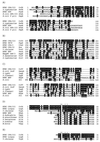Gene cluster for assembly of pilus colonization factor antigen III of enterotoxigenic Escherichia coli
- PMID: 11500465
- PMCID: PMC98705
- DOI: 10.1128/IAI.69.9.5864-5873.2001
Gene cluster for assembly of pilus colonization factor antigen III of enterotoxigenic Escherichia coli
Abstract
The assembly of pilus colonization factor antigen III (CFA/III) of enterotoxigenic Escherichia coli (ETEC) requires the processing of CFA/III major pilin (CofA) by a prepilin peptidase (CofP), similar to other type IV pilus formation systems. CofA is produced initially as a 26.5-kDa preform pilin (prepilin) and then processed to a 20.5-kDa mature pilin by CofP which is predicted to be localized in the inner membrane. In the present experiment, we determined the nucleotide sequence of the whole region for CFA/III formation and identified a cluster of 14 genes, including cofA and cofP. Several proteins encoded by cof genes were similar to previously described proteins, such as the toxin-coregulated pili of Vibrio cholerae and the bundle-forming pili of enteropathogenic E. coli. The G+C content of the cof gene cluster was 37%, which was significantly lower than the average for the E. coli genome (50%). The introduction of a recombinant plasmid containing the cof gene cluster into the E. coli K-12 strain conferred CFA/III biogenesis and the ability of adhesion to the human colon carcinoma cell line Caco-2. This is the first report of a complete nucleotide sequence of the type IV pili found in human ETEC, and our results provide a useful model for studying the molecular mechanism of CFA/III biogenesis and the role of CFA/III in ETEC infection.
Figures







References
Publication types
MeSH terms
Substances
Associated data
- Actions
LinkOut - more resources
Full Text Sources

